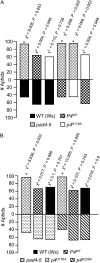Discrimination of Arabidopsis PAD4 activities in defense against green peach aphid and pathogens
- PMID: 22353573
- PMCID: PMC3320191
- DOI: 10.1104/pp.112.193417
Discrimination of Arabidopsis PAD4 activities in defense against green peach aphid and pathogens
Abstract
The Arabidopsis (Arabidopsis thaliana) lipase-like protein PHYTOALEXIN DEFICIENT4 (PAD4) is essential for defense against green peach aphid (GPA; Myzus persicae) and the pathogens Pseudomonas syringae and Hyaloperonospora arabidopsidis. In basal resistance to virulent strains of P. syringae and H. arabidopsidis, PAD4 functions together with its interacting partner ENHANCED DISEASE SUSCEPTIBILITY1 (EDS1) to promote salicylic acid (SA)-dependent and SA-independent defenses. By contrast, dissociated forms of PAD4 and EDS1 signal effector-triggered immunity to avirulent strains of these pathogens. PAD4-controlled defense against GPA requires neither EDS1 nor SA. Here, we show that resistance to GPA is unaltered in an eds1 salicylic acid induction deficient2 (sid2) double mutant, indicating that redundancy between EDS1 and SID2-dependent SA, previously reported for effector-triggered immunity conditioned by certain nucleotide-binding-leucine-rich repeat receptors, does not explain the dispensability of EDS1 and SID2 in defense against GPA. Mutation of a conserved serine (S118) in the predicted lipase catalytic triad of PAD4 abolished PAD4-conditioned antibiosis and deterrence against GPA feeding, but S118 was dispensable for deterring GPA settling and promoting senescence in GPA-infested plants as well as for pathogen resistance. These results highlight distinct molecular activities of PAD4 determining particular aspects of defense against aphids and pathogens.
Figures








Similar articles
-
PAD4-dependent antibiosis contributes to the ssi2-conferred hyper-resistance to the green peach aphid.Mol Plant Microbe Interact. 2010 May;23(5):618-27. doi: 10.1094/MPMI-23-5-0618. Mol Plant Microbe Interact. 2010. PMID: 20367470
-
Green peach aphid infestation induces Arabidopsis PHYTOALEXIN-DEFICIENT4 expression at site of insect feeding.Plant Signal Behav. 2012 Nov;7(11):1431-3. doi: 10.4161/psb.22088. Epub 2012 Sep 18. Plant Signal Behav. 2012. PMID: 22990443 Free PMC article.
-
Phloem-based resistance to green peach aphid is controlled by Arabidopsis PHYTOALEXIN DEFICIENT4 without its signaling partner ENHANCED DISEASE SUSCEPTIBILITY1.Plant J. 2007 Oct;52(2):332-41. doi: 10.1111/j.1365-313X.2007.03241.x. Epub 2007 Aug 24. Plant J. 2007. PMID: 17725549
-
Plant immunity: the EDS1 regulatory node.Curr Opin Plant Biol. 2005 Aug;8(4):383-9. doi: 10.1016/j.pbi.2005.05.010. Curr Opin Plant Biol. 2005. PMID: 15939664 Review.
-
Plant defence against aphids: the PAD4 signalling nexus.J Exp Bot. 2015 Feb;66(2):449-54. doi: 10.1093/jxb/eru454. Epub 2014 Nov 21. J Exp Bot. 2015. PMID: 25416793 Review.
Cited by
-
The ethylene response factor Pti5 contributes to potato aphid resistance in tomato independent of ethylene signalling.J Exp Bot. 2015 Feb;66(2):559-70. doi: 10.1093/jxb/eru472. Epub 2014 Dec 11. J Exp Bot. 2015. PMID: 25504643 Free PMC article.
-
The Arabidopsis RNA Polymerase II Carboxyl Terminal Domain (CTD) Phosphatase-Like1 (CPL1) is a biotic stress susceptibility gene.Sci Rep. 2018 Sep 7;8(1):13454. doi: 10.1038/s41598-018-31837-0. Sci Rep. 2018. PMID: 30194343 Free PMC article.
-
SgR1, Encoding a Leucine-Rich Repeat Containing Receptor-like Protein, Is a Major Aphid (Schizaphis graminum) Resistance Gene in Sorghum.Int J Mol Sci. 2024 Dec 24;26(1):19. doi: 10.3390/ijms26010019. Int J Mol Sci. 2024. PMID: 39795877 Free PMC article.
-
Small Molecule DFPM Derivative-Activated Plant Resistance Protein Signaling in Roots Is Unaffected by EDS1 Subcellular Targeting Signal and Chemical Genetic Isolation of victr R-Protein Mutants.PLoS One. 2016 May 24;11(5):e0155937. doi: 10.1371/journal.pone.0155937. eCollection 2016. PLoS One. 2016. PMID: 27219122 Free PMC article.
-
Molecular Interactions Between Plants and Aphids: Recent Advances and Future Perspectives.Insects. 2024 Nov 28;15(12):935. doi: 10.3390/insects15120935. Insects. 2024. PMID: 39769537 Free PMC article. Review.
References
-
- Birker D, Heidrich K, Takahara H, Narusaka M, Deslandes L, Narusaka Y, Reymond M, Parker JE, O’Connell R. (2009) A locus conferring resistance to Colletotrichum higginsianum is shared by four geographically distinct Arabidopsis accessions. Plant J 60: 602–613 - PubMed
-
- Blackman RL, Eastop VF. (2000) Aphids on the World’s Crops: An Identification and Information Guide, Ed 2. John Wiley, Chichester, UK
-
- Blow D. (1990) More of the catalytic triad. Nature 343: 694–695 - PubMed
Publication types
MeSH terms
Substances
Associated data
- Actions
- Actions
- Actions
- Actions
LinkOut - more resources
Full Text Sources
Molecular Biology Databases

